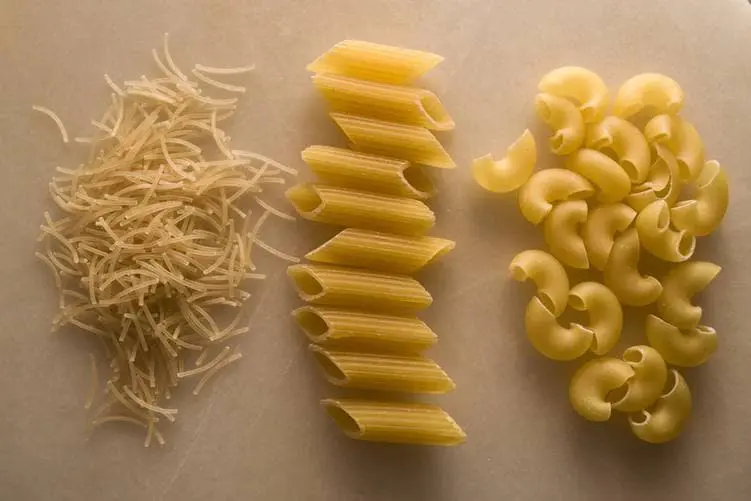There was a legend in the Soviet Union: supposedly the militarization of Soviet industry had reached the point that even the equipment of pasta factories was designed so that in case of war it could be transferred to the production of cartridges. That is why the pasta was the same diameter as a cartridge caliber - 7.62 mm. We checked whether this is actually true.
For example, here is a fragment material publication "Free Press". It is called “Why even pasta in the USSR had the caliber of a Kalashnikov assault rifle”:
“After the end of the Great Patriotic War, the Soviet government drew appropriate conclusions not only from the defeats of 1941, but also from the experience of military-industrial mobilization. Many decisions were made, including those related, in particular, to ammunition. For example, factories for the production of pasta and tobacco products (cigarettes and cigarettes) were built in such a way that their equipment could be rebuilt in the shortest possible time for the production of cartridges. For this purpose, it was customary to produce holes in pasta matrices with a diameter of 7.62 and 5.45 mm. That is, to unify this equipment for the production of cartridges.”
After the collapse of the USSR, the legend about pasta, from which cartridges can be made, was preserved and turned out to be very tenacious: stories about such pasta began to appear in Russian media.
At the same time, it is now difficult to establish the exact date of birth of the story about pasta cartridges, but the writer Boris Vasiliev was the first to record it on paper in stories "The Wilderness" 2001. Here is an excerpt from this story:
“Is it possible to make cartridges in a pasta factory? I answer: it is possible if the caliber of the pasta is 7.62. A factory of exactly this caliber was opened by comrade Anastas Ivanovich Mikoyan even before the war in the village at the Glukhoman station. In the shops for trade and display purposes, pasta was packaged, and behind them, in the depths of the territory, behind additional barbed wire and even more barbed security, meanwhile, cartridges of the most familiar type were calmly stamped.
In 1941, trains from Tula with machine tools from arms factories began arriving at our station. And they quickly set up production of the famous 7.62-caliber rifles from the Civil War, five-shot model 1891/30. Then the war ended, but production remained. For this, the village of Glukhoman received the status of a city and even became a regional center of all-Union pasta significance. In those days, it was somehow not customary to talk about rifles with cartridges... The conveyor, throwing out zinc cartridge boxes, clanged its joints in one workshop, rifles were produced in another, assembly and packaging - in the third and fourth, and the rest, as they say, were drilling holes in the pasta.”
Claims about pasta-cartridges were not only in works of fiction, but also in the media. In 2008, in the article “Quasi-militarism” on the website Gazeta.ru, Yulia Latynina stated: “Stalin’s factories produced either tanks or the steel from which tanks were made. Back in the 70s, pasta in the USSR was produced in 7.62 mm caliber, so that in case of war, the machines would immediately switch to producing cartridges.”
Even some military experts believed in the legend of cartridge-caliber pasta. For example, one of the lectures by military observer Alexander Golts on the Novaya Gazeta website received subtitle: “Cigarettes, like pasta in the USSR, were 7.62 caliber.” In the lecture, Goltz repeated the legend that in the USSR pasta was of a size that allowed the production of sleeves on equipment for the production of pasta.
However, the statement about pasta the size of cartridges is apparently still incorrect, and Vasiliev, Latynina and Golts fell victims to a beautiful legend.
Firstly, pasta and pasta factories appeared long before the emergence of the 7.62 x 54R cartridge (as well as the so-called 7.62 x 39 intermediate cartridge, which was used in the Kalashnikov assault rifle, and the 5.45 x 39 cartridge, with which Soviet pasta is also compared).
How indicates in his LiveJournal and magazine “Bread & Salt”, modern culinary historian Pavel Syutkin, pasta production in Russia started back in 1883, and in the USSR it was only able to be revived in the 1920s.
Secondly, the “caliber” of Soviet pasta did not at all correspond to the caliber of ammunition.
During wartime in the USSR there were two standards for pasta: GOST 875–41 — pasta products (last digits indicate the year the standard was adopted), GOST V-875–43 - pasta products. In 1969, the first post-war GOST for pasta (GOST 875–51) was replaced in 1969 by GOST 875–69. And tubular pasta was produced along it, but the dimensions were completely different. Straws with a diameter of 4 mm, special ones - 4.1–5.5 mm, ordinary ones - from 5.6 to 7 mm and amateur ones - from 7 mm and more.
The last pasta GOST from the times of the USSR - 875-92, also does not give grounds to talk about the same sizes of Soviet paste and cartridges. In 1992, “ordinary pasta” was produced with a diameter of 5 to 7 mm, ordinary corrugated - from 5.6 to 7 mm, special - from 4 to 5.5 mm, and amateur and straws repeated the 1969 GOST standards.
By the way, the same can be said about cigarettes. About them was exactly the same legend: supposedly the diameter of Soviet cigarettes was 7.62 mm. So, this is also not according to Soviet GOST.
According to GOST 1505-48, in the USSR three types of cigarettes were produced with sleeve diameters of 7.2, 8.2 and 8.8 mm, and tissue paper width standards prescribed sizes of 25, 28 and 30 mm. The standard was adopted back in the 30s of the last century, it was repeated in GOST 1981 and has not changed to this day.
But the main argument that refutes the myth about cartridge-pasta factories in the USSR lies in the technological differences in the production of these products. Since the 19th century, round pasta, including thick pasta with a hole, was produced by squeezing the dough in a press through an attachment with holes.
Examples of these processes can be seen, for example, Here And Here.
Unlike pasta, a cartridge case, like a copper bullet casing, is not obtained by drilling (as the writer Vasiliev believed) or by twisting (as Alexander Golts, Yulia Latynina and many Soviet citizens were sure).
When creating a sleeve from a sheet of brass, steel or a bimetallic alloy, a cylindrical blank is cut. Then it is pulled out several times by pressing, turning it into a hollow cylinder. Then the bottom is stamped for installing the primer, the slope is stamped, and the rim is grooved, which serves to remove the spent cartridge case from the weapon.
You can see how the production of a cartridge case and a bullet and their subsequent connection into a cartridge takes place, for example, in this plot American Shooter program with Mossad Ayoub.
Thus, the equipment and technological processes are quite different. And transferring a pasta factory onto a military footing, even if possible, is very complicated and will require an almost complete replacement of equipment and personnel. And the story about Soviet cartridge-caliber pasta is just a beautiful urban legend.
Not true
- History of Russian cuisine
- How Pasta Is Made - How It's Made
- Modern Ammunition Manufacturing Process - Inside Bullets Factory
If you find a spelling or grammatical error, please let us know by highlighting the error text and clicking Ctrl+Enter.







